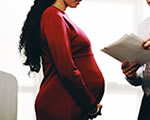 Go to main content
Go to main content
Archive Website of the UK government
Please note that this website has a UK government accesskeys system.
Main menu
Page menu
Government, citizens and rights

Registering a birth record following fertility treatment or surrogacy

If your child is conceived through fertility treatment or a surrogacy agreement, find out more how the birth is registered and what changes may then be made.
Registering a baby conceived after fertility treatment or surrogacy
The woman who gives birth, including a surrogate mother, is recorded as the child's mother. The man regarded as the father will usually be the husband or partner who received treatment with the mother.
In the case of a surrogacy arrangement, the ‘commissioning parents’ – the couple who arranged for the surrogate mother to carry a child for them - can apply to the courts for a Parental Order that allows them to re-register the birth and be named as the child’s parents. You should seek legal advice if you wish to apply for a Parental Order.
On issuing a Parental Order, the court notifies the General Register Office automatically, who re-register the birth. This new birth record supersedes the original.
You will not need to do anything further, unless you would like a new birth certificate showing the details of the commissioning parents as the parents of the child.
Details on how to obtain certificates of the new record will be provided when the new record has been made.
Changes in the law on legal parentage following fertility treatment
The Human Fertilisation and Embryology Act 2008, which comes into effect on 6 April 2009, affects who can be registered as a child's legal parents when the child has been conceived following fertility treatment.
These new provisions will apply only when the woman receiving treatment conceives on or after this date.
If the father dies before a child is conceived
If a child is conceived through fertility treatment after the death of the man receiving treatment with the mother, it is possible for the man to be registered as the child’s father either when the birth is registered, or at a later date if he was not named initially.
If the birth has been registered without the father’s details, it can be re-registered to include them, but you will need the following:
- the man’s written consent to the fertility treatment and to being named as the father in the child's birth registration - this is only applicable if the man died before 18 September 2023
- written confirmation from the clinic that the man's consent had not been withdrawn - this is only applicable if the man died before 18 September 2023
- written confirmation of the fertility treatment from a medical source, such as the treatment clinic, mother's own doctor or hospital doctor
- the mother’s written request for the man to be named as the father in the birth registration
- the man’s original death certificate, (a photocopy is not acceptable) - if he died in England or Wales, details of when and where he died will be sufficient
- an original marriage certificate where appropriate, a photocopy is not acceptable - if the marriage ceremony took place in England or Wales, details of where and when will be sufficient
Note that recording the man as a child's father in these circumstances does not mean he will be treated in law as the child’s father for any purpose other than registration. For example, it does not give the child any legal status or rights concerning inheritance or nationality. If you would like further information, seek legal advice.
You will need to complete several forms. To obtain them either:
- contact a local register office
- contact the General Register Office on +44 (0)151 471 4806
or email:
corrections.re-reg@ips.gsi.gov.ukFor further information on treatment services and deceased fathers, visit the Human Fertilisation and Embryology Authority.
For events in Scotland or Northern Ireland
You can contact the relevant General Register Office using the links below.
 Facebook
Facebook Twitter
Twitter StumbleUpon
StumbleUpon Delicious
Delicious Reddit
Reddit